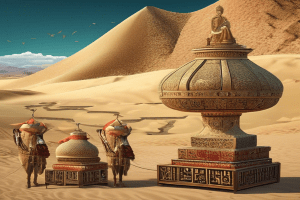The Silk Roads Book:
Peter Frankopan’s broadly commended book, “The Silk Roads: One More Arrangement of Encounters of the World,” is an insightful masterpiece that takes perusers on an enthralling trip through the crossing point of developments. Dispersed in 2015, this fantastic work challenges customary, obvious stories and gives another perspective on the interconnectedness of human social orders along the Silk Roads.
Mapping the Silk Roads:
Frankopan conveniently coordinates perusers through the tangled associations of the Silk Roads, unraveling the complexities of these old transportation paths. Unlike standard narratives that much of the time revolve around the West, “The Silk Roads” presents a story that places Central Asia, the Middle East, and Asia at the center of overall new developments. Frankopan battles that these areas were periphery players as well as somewhat basic in framing the course of world history.
Cultural Crossroads:
One of the book’s enormous responsibilities is its examination of the Silk Roads as some different options for channels for trade. Frankopan highlights how these courses functioned with a huge social exchange, where contemplations, developments, and strategies for thinking were shared and changed. The book uncovers an understanding of the responsibilities of the East to the progression of the West, testing Eurocentric perspectives and highlighting the common improvements that portrayed the Silk Roads.
Geopolitical Significance:
“The Silk Roads” goes past monetary trades and examines the worldwide meaning of these old courses. Frankopan shows how the ever-changing development of power along the Silk Roads influenced the climb and fall of domains. The control of focal issues along these transportation paths transformed into a fundamental asset, forming the destiny of nations and spaces.
Relevance to Modern Times:
The book’s significance stretches beyond its true story, offering pieces of information on contemporary issues. Frankopan contends that understanding the unquestionable components of the Silk Roads is crucial for getting a handle on the worldwide challenges of the present. As the world ends up being logically interconnected, the models from the Silk Roads resound in discussions about globalization, social exchange, and its general impact.
“The Silk Roads: One More Arrangement of Encounters of the World” is a show-stopper that captivates perusers with its rich description and particular investigation. By putting the Silk Roads at the point of convergence of humankind’s arrangement of encounters, Peter Frankopan has given a persuading and speedy record that challenges the standard perspective. The book’s importance lies in its ability to offer a more complete and interconnected perception of our normal human past, enabling perusers to see the worth in the complexities and nuances of the world’s irrefutable weaving. In a period where overall affiliations are more expressed than at some other time, “The Silk Roads” fills in as a sign, guiding us to explore the rich exchanges of social orders, considerations, and municipal foundations that have framed our world.
Fun facts about the Silk Road:
- Diverse Trade Treasures: Beyond silk, the Silk Street exchanged a variety of fortunes, including flavors, valuable metals, and even rhubarb.
- Cultural Crossroads: Investigate how the Silk Street was a mixture of societies, cultivating the trading of thoughts, religions, and creative impacts.
- Innovations Galore: Did you know the Silk Street worked with the spread of game-evolving advancements? Papermaking and the compass are only two or three of the jewels that advanced along these antiquated courses.
- Marco Polo’s Odyssey: Find the incredible stories of Marco Polo, whose experiences along the Silk Street acquainted the Western world with the miracles of the East.
- Economic Empires: Reveal the monetary forces to be reckoned with that flourished along the Silk Street, with clamoring markets and prospering urban communities forming the course of worldwide exchange.
- Nomadic Nomads: Find out about the migrant clans whose ways of life were unpredictably attached to the Silk Street, adding to the recurring pattern of products and thoughts.
Life along the Silk Road:
Step into the lively embroidery of life along the noteworthy Silk Street, where each string recounts an account of human strength and social extravagance. Picture clamoring commercial centers where the fragrance of outlandish flavors blends with the gab of vendors wrangling over silks, jewels, and flavors.
The Silk Street wasn’t simply a shipping lane; it was a help of variety, interfacing individuals from East to West. Families shared stories around open-air fires, appreciating the kinds of local cooking styles that intertwined along these antiquated pathways.
Migrant clans, with their complicatedly woven rugs and stories of far-off lands, left a permanent imprint on the scene. Close by the clunking parade ringers, thoughts streamed unreservedly, from the complicated specialty of papermaking to the relieving songs of different melodic practices.
Go along with us on a virtual excursion through time, where the heartbeat of the Silk Street reverberates through the chuckling, battles, and shared humankind of the individuals who once strolled its ways. Drench yourself in the living history of Silk Street and find the strong soul that rose above borders.

